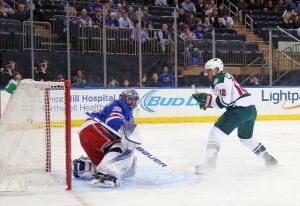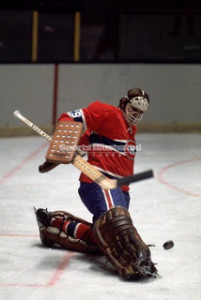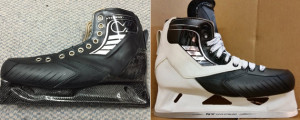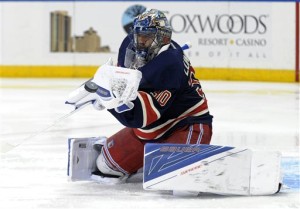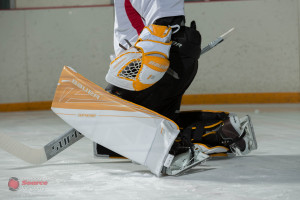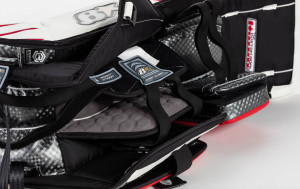The Rangers came out victorious over the Minnesota Wild last night, in a game they more or less dominated after falling behind 2-0. Since I’m tired of writing about the maddening win, loss, win, loss pattern of late, I’m going to update you on some of the advancements in goalie equipment that 2016 holds in store.
The biggest advances are coming in the form of skates and goal pads. Companies like Bauer, VH Hockey and Brian’s are working to change the way goaltenders approach gear, and the industry, as whole going forward. Let’s start with the new skates…
Skates
Since the dawn of time, goalie skates have been wrapped in a protective plastic known as a “cowling”. At the beginning, this layer of coverage was designed to minimize puck impact to both the toes (which were at one point open), and the inside of the foot when making skate saves. In a strange bizzaro world, goalies used to turn the inside of their feet toward the shot in order to maximize lateral coverage. Not so much these days.
I wrote an article a few years back about Bauer changing the type of cowling they employed to minimize this now useless inner skate coverage and create a greater attack angle for the goaltender. Subsequently, brands like CCM and Graf have followed suit with slimmed down cowlings to take advantage of these features. Since attack angle is all the rage, the newer advancements have been squarely focused on eliminating interference between the goalie’s skate blade and the ice.
Enter the cowling-less goal skate. So far, only Bauer and newcomer VH Hockey have introduced these models, claiming at least a 10% increase in attack angle and significant weight reduction over the outgoing models. Don’t be surprised to see the trend continue.
Bauer Supreme 1S
These are the skates that Henrik Lundqvist is currently wearing. From a far, they look like a skate any other player would wear. They have a traditional exposed boot and riveted holder. On closer inspection, however, they have a reinforced toe and long, flat blade more reminiscent of your traditional goalie skate. Hank has been lauding their performance thus far. This style of skate dominates the Bauer goal skate line for 2016, showing the faith the company has in its new release.
In my experience, when Bauer brings a radical new product design to market, the original incarnation is the best. Obviously, as the years pass, new models are introduced, but few are significant improvements on the original (see Vapor XX, Bauer One100). The Supreme 1S skates hit shelves nationwide in April.
VH One-Piece
A relatively obscure company out of Winnipeg, VH Hockey has traditionally been a speed skating company. They have made big waves in the NHL recently; with such NHL stars Dustin Byfuglien, Andrew Ladd, Ryan Miller, Jonas Hiller and Carey Price wearing their boots.
For 2016, the company worked closely with Ryan Miller to create a complete one piece, cowling-less design, integrating both the boot and blade holder. The skates are made with aerospace grade carbon fiber, fused to a thermoplastic shell. It is completely moldable to the goaltender’s foot. The benefit to this design (outside of the obvious) is that, with no rivets or other separation from the boot and holder, maximum energy transfer is achieved on lateral pushes.
This new skate is out of its prototype phase and is currently targeting a release between May and July 2016.
Pads
With the NHL getting faster ever year, a major focus for goalie equipment has been weight reduction. Many brands have begun shaving the traditional leather straps and buckles off of pads in favor of elastic strapping systems. Internal materials have been getting lighter and balance of weight has been shifted to create a less cumbersome design. Companies like Vaughn and CCM are still very much innovating a creating high-quality new products, but for 2016, two companies stand out in the innovation department: Bauer and Brian’s.
Bauer Supreme 1S OD1N
Keeping with the trend of Henrik Lundqvist being on the forefront of innovative equipment design, you may have noticed Hank switching his pads over the past few weeks. In reality, he has just updated his graphics to mirror Bauer’s retail release, as he has been wearing a variation of this technology for the past few seasons. He was instrumental in Bauer designing the 1S pad, and has been a pioneer in weight reduction with his equipment.
For the 1S pad, Bauer has focused on hard rebounds. When the puck makes impact with the pad, the idea is that the rebound goes further out of the danger area, giving the goaltender more time to recover. This is reflected in the technology of the pad build. The skin of the pad is designed to return to its original form quicker than the segmented construction of other pads, thus giving harder rebounds. It is also a layered technology, with the graphics screen printed on, rather than sewn.
This technique has lead to greater consistency on the surface of the pad, and the tight wrap of the skin allows for less friction and farther lateral pushes in the butterfly slide.
From a construction standpoint, there are no natural breaks in the pads, but the rigid design mimics a break at the knee. The top section of the pad is designed remain rigid, reducing five-hole exposure. Bauer also incorporates its 37.5 cooling technology and a simplified sizing system.
As with the 1S goal skate, the leg pads will be available for retail purchase in April 2016, and should have a major impact on the future of goalie equipment.
Brian’s Sub-Zero 3
While not quite as radical as the new Bauer line, the folks at Brian’s have created a tremendous achievement in their own right with the new Sub-Zero 3, worn by the Rangers’ own Antti Raanta. The theory behind the pads is very similar to Bauer’s, but with a little more subdued execution. The construction is more traditional, but a flat, binding-less face creates a similarly effective seal, while keeping weight down.
As opposed to all-out weight reduction and hard rebounds, Brian’s opted for something of a middle ground. While early indications are the Sub-Zero 3 pads are comparable in weight to the Bauer’s, their focus has been ice seal. One of the subtler features of the pads in a slightly inset knee stack. Since the knee is the heaviest point of contact with the ice, it makes sense to give it a little more space, as to keep the calf portion effectively sealed.
Brian’s really makes the pad with its advances in materials. Their primo synthetic lines the knee and boot channels of the pad, while the Hex-Air leg channel keep the pad breathable while providing grip.
The Sub-Zero 3 line is currently available through retailers.
Over the next few years, expect these types of advancements to continue in light of additional proposed equipment restrictions. Goalies will have to get faster and lighter to keep up with the increased speed and power in the game. I hope you all enjoyed this primer on the new trends in the goaltending industry. I would love to hear you thoughts in the comments below.
Share:
More About:Goaltending

